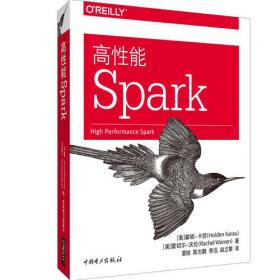
高性能Spark
全新正版 极速发货
¥ 42.3 4.8折 ¥ 88 全新
仅1件
广东广州
认证卖家担保交易快速发货售后保障
作者(加)霍尔顿·卡劳(Holden Karau),(加)雷切尔·沃伦(Rachel Warren) 著
出版社东南大学出版社
ISBN9787564175184
出版时间2018-02
装帧平装
开本16开
定价88元
货号1201663888
上书时间2024-11-13
- 最新上架
商品详情
- 品相描述:全新
- 商品描述
-
作者简介
Holden Karau是一位跨性别加拿大人,在IBM Spark技术中心担任软件开发工程师。她是Spark代码贡献者,并且经常提交贡献代码,特别是PySpark和机器学习部分。Holden在多个靠前活动中演讲Spark相关话题。
Rachel Warren是Alpine Data的软件工程师和数据科学家。在日常工作中,她使用Spark来处理真实世界的数据和机器学习问题。她也曾在工业界和学术界担任分析师和导师。
目录
Preface
1.Introduction to High Performance Spark
What Is Spark and Why Performance Matters
What You Can Expect to Get from This Book
Spark Versions
Why Scala?
To Be a Spark Expert You Have to Learn a Little Scala Anyway
The Spark Scala API Is Easier to Use Than the lava API
Scala Is More Performant Than Python
Why Not Scala?
Learning Scala
Conclusion
2.How Spark Works
How Spark Fits into the Big Data Ecosystem
Spark Components
Spark Model of Parallel Computing: RDDs
Lazy Evaluation
In-Memory Persistence and Memory Management
Immutability and the RDD Interface
Types of RDDs
Functions on RDDs: Transformations Versus Actions
Wide Versus Narrow Dependencies
Spark Job Scheduling
Resource Allocation Across Applications
The Spark Application
The Anatomy of a Spark lob
The DAG
Jobs
Stages
Tasks
Conclusion
3.DataFrames, Datasets, and Spark SQL
Getting Started with the SparkSession (or HiveContext or SQLContext)
Spark SQL Dependencies
Managing Spark Dependencies
Avoiding Hive JARs
Basics of Schemas
DataFrame API
Transformations
Multi-DataFrame Transformations
Plain Old SQL Queries and Interacting with Hive Data
Data Representation in DataFrames and Datasets
Tungsten
Data Loading and Saving Functions
DataFrameWriter and DataFrameReader
Formats
Save Modes
Partitions (Discovery and Writing)
Datasets
Interoperability with RDDs, DataFrames, and Local Collections
Compile-Time Strong Typing
Easier Functional (RDD "like") Transformations
Relational Transformations
Multi-Dataset Relational Transformations
Grouped Operations on Datasets
Extending with User-Defined Functions and Aggregate Functions (UDFs,UDAFs)
Query Optimizer
Logical and Physical Plans
Code Generation
Large Query Plans and Iterative Algorithms
Debugging Spark SQL Queries
JDBC/ODBC Server
Conclusion
4.Joins (SQL and Core)
Core Spark Joins
Choosing a Join Type
Choosing an Execution Plan
Spark SQL Joins
DataFrame Joins
Dataset Joins
Conclusion
5.Effective Transformations
Narrow Versus Wide Transformations
Implications for Performance
Implications for Fault Tolerance
The Spe Case of coalesce
What Type of RDD Does Your Transformation Return?
Minimizing Object Creation
Reusing Existing Objects
Using Smaller Data Structures
Iterator-to-Iterator Transformations with mapPartitions
What Is an Iterator-to-Iterator Transformation?
Space and Time Advantages
An Example
Set Operations
Reducing Setup Overhead
Shared Variables
Broadcast Variables
Accumulators
Reusing RDDs
Cases for Reuse
Deciding if Recompute Is Inexpensive Enough
Types of Reuse: Cache, Persist, Checkpoint, Shuffle Files
Alluxio (nee Tachyon)
LRU Caching
Noisy Cluster Considerations
Interaction with Accumulators
Conclusion
6.Working with Key/Value Data
The Goldilocks Example
Goldilocks Version 0: Iterative Solution
How to Use PairRDDFunctions and OrderedRDDFunctions
Actions on Key/Value Pairs
Whats So Dangerous About the groupByKey Function
Goldilocks Version 1: groupByKey Solution
Choosing an Aggregation Operation
Dictionary of Aggregation Operations with Performance Considerations
Multiple RDD Operations
Co-Grouping
Partitioners and Key/Value Data
Using the Spark Partitioner Object
Hash Partitioning
Range Partitioning
Custom Partitioning
Preserving Partitioning Information Across Transformations
Leveraging Co-Located and Co-Partitioned RDDs
Dictionary of Mapping and Partitioning Functions PairRDDFunctions
Dictionary of OrderedRDDOperations
Sorting by Two Keys with SortByKey
Secondary Sort and repartitionAndSortWithinPartitions
Leveraging repartitionAndSortWithinPartitions for a Group by Key and Sort Values Function
How Not to Sort by Two Orderings
Goldilocks Version 2: Secondary Sort
A Different Approach to Goldilocks
Goldilocks Version 3: Sort on Cell Values
Straggler Detection and Unbalanced Data
Back to Goldilocks (Again)
Goldilocks Version 4: Reduce to Distinct on Each Partition
Conclusion
7.Going Beyond Scala
Beyond Scala within the JVM
Beyond Scala, and Beyond the JVM
How PySpark Works
How SparkR Works
Spark.jl (Julia Spark)
How Eclair JS Works
Spark on the Common Language Runtime (CLR)——C# and Friends
Calling Other Languages from Spark
Using Pipe and Friends
JNI
Java Native Access (JNA)
Underneath Everything Is FORTRAN
Getting to the GPU
The Future
Conclusion
8.Testing and Validation
Unit Testing
General Spark Unit Testing
Mocking RDDs
Getting Test Data
Generating Large Datasets
Sampling
Property Checking with ScalaCheck
Computing RDD Difference
Integration Testing
Choosing Your Integration Testing Environment
Verifying Performance
Spark Counters for Verifying Performance
Projects for Verifying Performance
Job Validation
Conclusion
9.Spark MLlib and ML
Choosing Between Spark MLlib and Spark ML
Working with MLlib
Getting Started with MLlib (Organization and Imports)
MLlib Feature Encoding and Data Preparation
Feature Scaling and Selection
MLlib Model Training
Predicting
Serving and Persistence
Model Evaluation
Working with Spark ML
Spark ML Organization and Imports
Pipeline Stages
Explain Params
Data Encoding
Data Cleaning
Spark ML Models
Putting It All Together in a Pipeline
Training a Pipeline
Accessing Individual Stages
Data Persistence and Spark ML
Extending Spark ML Pipelines with Your Own Algorithms
Model and Pipeline Persistence and Serving with Spark ML
General Serving Considerations
Conclusion
10.Spark Components and Packages
Stream Processing with Spark
Sources and Sinks
Batch Intervals
Data Checkpoint Intervals
Considerations for DStreams
Considerations for Structured Streaming
High Availability Mode (or Handling Driver Failure or Checkpointing)
GraphX
Using Community Packages and Libraries
Creating a Spark Package
Conclusion
A.Tuning, Debugging, and Other Things Developers Like to Pretend Dont Exist
Index
内容摘要
本书描述了减少数据基础设施成本和开发时间的技巧,适用于软件工程师、数据工程师、开发者和系统管理员。你不仅可以从中获得关于Spark的全面理解,也将学会如何让它运转自如。
在本书中你将发现:
* Spark SQL的新接口如何在SQL的RDD数据结构上改善性能。
* Core Spark和Spark SQL之间的数据拼接选择。
* 充分发挥标准RDD转换功能的技巧。
* 如何处理Spark的键/值对范式的相关性能问题。
* 编写高性能Spark代码,不使用Scala或JVM。
* 如何在应用建议的改进措施时测试功能和性能。
* 使用Spark MLlib和Spark ML机器学习库。
* Spark的流组件和外部社区软件包。
相关推荐
— 没有更多了 —






















以下为对购买帮助不大的评价